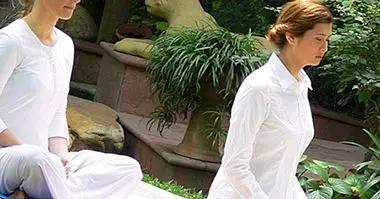How to learn to meditate, in 7 easy steps
Meditation is a millenary practice that is experiencing great popularity in the West in the last decade, because there are many benefits for mental and emotional wellbeing and it is very useful in these times. Whether to calm the mind, to find oneself or to reduce anxiety or stress, more and more people are interested in introducing this practice in their daily lives, improving their quality of life.
But meditating is not always easy, especially at the beginning, because it requires discipline and practice for its perfection. and as much as it is apparently not physically demanding, it also requires effort. Nothing is free in this life, but if you know everything that meditation can bring to your life, it is quite likely that you will feel the need to begin to familiarize yourself with its techniques.
The benefits of meditation
In recent years, research on this practice has shown that meditation is effective in improving people's mental health. What are these benefits? What is the use of meditating? Meditation benefits us for different reasons:
- Mitigate the effects of stress
- It positively affects the immune system
- Improves the attention and concentration capacity
- It is useful to empathize with others
- Increase pain tolerance
- Improves memory and cognitive functions
- Power the emergence of positive thoughts
You can learn more about these benefits in our article: "Benefits of meditation supported by science"
The 7 steps to learn to meditate
The key to developing the habit of meditation is to find the perfect moment for you and the kind of meditation and posture that fits you. At first you can experiment with the different types of meditation and the correct posture to find the necessary comfort and the ideal mental state to carry this practice out.
But you must know that in order to overcome the resistances that you may sometimes encounter during the meditative process, moving on with the practice is what really makes you better. If you want to know how to meditate correctly, follow these steps that I indicate to you next.
1. Put on comfortable clothes
The first thing you must do to meditate and be in the here and now is to wear comfortable clothes. Removing your shoes and choosing a wide garment is the best alternative to feel ready to meditate . Forget about tight clothes and take off your watch or other accessories that may be annoying.
2. Find a quiet place
It is necessary to find a place that allows you to be relaxed and without interruptions or interference. It can be the room of your house, the seashore or your garden ... Any place is good if it allows you to be comfortable and focused, totally immersed in the activity that you are going to start.
3. Sit correctly
To meditate you must sit correctly, that is, on the ground with your back straight, but without tensions , breathing deeply and keeping the shoulders and arms relaxed. Some people prefer to sit in a chair or on their knees instead of the classic posture, and there is also lying meditation. Whatever position you adopt, the back should always be straight and the body, especially the shoulders and arms, relaxed.
4. Focus on an object
Focus on an object or on breathing (with closed eyes) when you start meditative practice . Later, you can perform other types of meditation, such as "body scan" or meditation centered on sounds.
5. Accept the thoughts that arise and move forward
It is usual that, during the practice of meditation, different thoughts arise: our personal problems, the discomfort of the moment or the insecurity of being doing meditation well or not (something that usually happens when we start in this practice). But this is something normal and, therefore, we must accept it .
Meditation focuses on the idea that psychological well-being is a state that emerges from the acceptance of thoughts, emotions and bodily sensations without trying to eliminate or modify them, simply observe them in a non-judgmental way. So, c When these thoughts appear, you just have to accept them and then refocus your attention on the object , breathing, sound or body sensation.
6. Increase your meditation time progressively
When you start in meditation, you should start little by little to then increase the time . It is ideal to start with one minute meditation, to progressively reach the 20 or 30 minutes a day that will help you improve your well-being.Take a look at this video to know what is the one minute meditation:
7. Add it to your daily routine
After reading the previous steps, Now you are ready to make meditation a healthy habit . With practice you will become a great meditator, which will help you achieve the benefits of this millenary practice.
Summary
It is scientifically proven that the practice of Mindfulness meditation has the potential to improve the quality of your life. On the other hand, there is a recommended application that combines all these 7 tips.
- Along with the guide of a former Buddhist monk, you can try it for free for a week: www.claridad.io

Psychology and meditation: Mindfulness exercises
In recent decades, meditation has become part of psychological therapy (for example, thanks to cognitive therapy based on Mindfulness or MBCT), but has also begun to be implemented in organizations, schools or sports.
And is that, from psychology, many professionals have realized the benefits of meditation, and specifically mindfulness, for mental health, interpersonal relationships, creativity or optimal performance, whether in sports, school or the job.
- If you want to get started in mindfulness practice, we advise you to read the following article: "5 Mindfulness exercises to improve your emotional well-being"



















